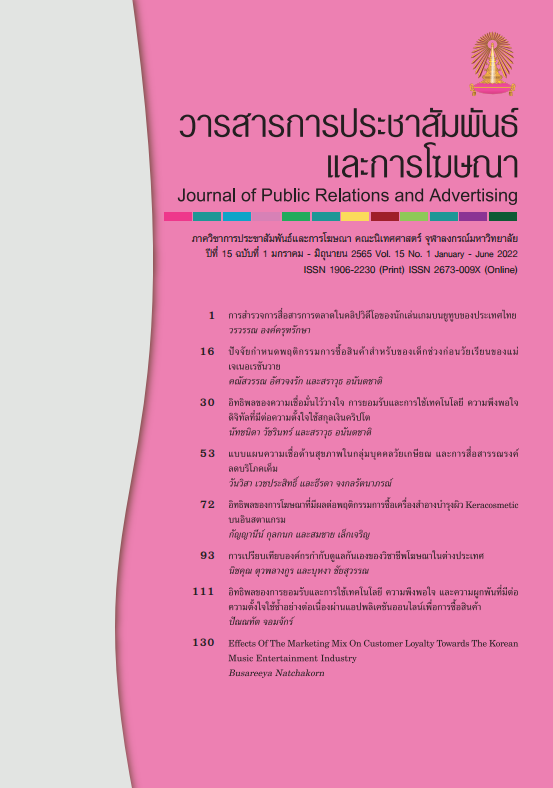Influencing of Advertising to Buying Behaviours Keracosmetic Cosmetic in Body Lotion on Instagram of Consumers
Main Article Content
Abstract
This research aims to develop and validate the consistency of a causal of relationship model of buying behaviours Keracosmetic cosmetic in body lotion on Instagram of consumers in Bangkok Metropolitan region; and to study the influencing causal factors of buying behaviours Keracosmetic cosmetic in body lotion on Instagram of consumers in Bangkok Metropolitan region. The tools used in the research were online questionnaires. The sample group consisted of 300 people who have been the consumer buying behaviours Keracosmetic cosmetic in body lotion on Instagram. The statistics used in data analysis were frequency, percentage, mean, standard deviation, skewness, kurtosis and the structural equation model. The results of this research were the development of the causal relationship models consisted of 4 components; 1) Advertising 2) Consumer Awareness 3) Consumer Perception and 4) Consumer Buying Behaviours and the model was consistent whit the empirical data to a great extent. The final result was a predictive coefficient of 0.56, indicating that the variables in the model can explain the variance of the consumer buying behaviours Keracosmetic cosmetic in body lotion by 56 percent. It was found that the consumer awareness were direct effect and Advertising were indirect effect to influence on consumer buying behaviours Keracosmetic cosmetic in body lotion on Instagram.
Article Details
References
กรมควบคุมโรค กระทรวงสาธารณสุข. (2563). ผลกระทบต่อสุขภาพจากสารเคมีปี 2563. วันที่เข้าถึงข้อมูล 10 ตุลาคม 2563. แหล่งที่มา http://envocc.ddc.moph.go.th/contents/view/106
กระทรวงดิจิทัลเพื่อเศรษฐกิจและสังคม. (2563). ผลสำรวจพฤติกรรมผู้ใช้อินเตอร์เน็ตปี 2562. วันที่เข้าถึงข้อมูล 9 พฤศจิกายน 2563. แหล่งที่มา https://www.everydaymarketing.co/trend-insight/etda-2020-thai-internet-behaviour/
กริช แรงสูงเนิน. (2554). การวิเคราะห์ปัจจัยด้วย SPSS และ AMOSเพื่อการวิจัย. กรุงเทพฯ: ซีเอ็ดยูเคชั่น.
กฤตยา อุ่นอ่อน. (2559). การศึกษาปัจจัยที่ส่งผลต่อการตัดสินใจซื้อครีมบำรุงผิวหน้าของผู้บริโภคในกรุงเทพมหานคร. การค้นคว้าอิสระบริหารธุรกิจมหาบัณฑิต. มหาวิทยาลัยกรุงเทพ.
กฤษณีกร เจริญกุศล และ กัญญานีน์ กุลกนก. (2561). ภาพลักษณ์การเป็นสังคมแห่งการให้ของมหาวิทยาลัยรังสิตผ่านการสื่อสารการตลาด. การประชุมวิชาการระดับชาติและระดับนานาชาติ มหาวิทยาลัยรังสิต ครั้งที่ 4 “Big Data and New Face of Asia: Reflection in Science, Arts, Social Science and Humanities” (น. 1093-1102). มหาวิทยาลัยรังสิต. ไทย. สืบค้นจาก https://rsucon.rsu.ac.th/proceeding/article/2189
กานต์ เตรียมศิริวรกุล. (2563). เทรนด์ตลาดเครื่องสำอางในยุค COVID-19. วันที่เข้าถึงข้อมูล 10 พฤศจิกายน 2563. แหล่งที่มา https://www.unboxbkk.com/beauty-trend-covid-19/
เกษกนก ศศิบวรยศ. (2556). การรับรู้คุณภาพการให้บริการและคุณค่าที่รับรู้ส่งผลต่อความภักดีของผู้มาใช้บริการคลินิกผิวหนังและความงามของประชาชนในเขตจังหวัดชลบุรี. การค้นคว้าอิสระบริหารธุรกิจมหาบัณฑิต. มหาวิทยาลัยกรุงเทพ.
ชลชินี บุนนาค. (2560). การสำรวจรูปแบบการดำเนินชีวิตบนอินสตาแกรม Exploring Lifestyle on Instagram. การค้นคว้าอิสระนิเทศศาสตร์มหาบัณฑิต. มหาวิทยาลัยกรุงเทพ.
ชูชัย สมิทธิไกร. (2561). พฤติกรรมผู้บริโภค. (พิมพ์ครั้งที่ 6). กรุงเทพฯ: โรงพิมพ์แห่งจุฬาลงกรณ์มหาวิทยาลัย.
ชไมพร กาญจนกิจสกุล. (2555). ระเบียบวิธีวิจัยทางสังคมศาสตร์ Research methodology in social sciences. พิมพ์ครั้งที่ 1. ตาก : โพรเจ็คท์ ไฟฟ์-โฟว์.
นงลักษณ์ วิรัชชัย. (2542). โมเดลลิสเรล: สถิติวิเคราะห์สำหรับการวิจัย. (พิมพ์ครั้งที่ 3). กรุงเทพฯ: โรงพิมพ์แห่งจุฬาลงกรณ์มหาวิทยาลัย.
นวฤทธิ์ อัคควรกิจ. (2551). กลยุทธ์การสร้างสรรค์งานโฆษณา. (พิมพ์ครั้งที่ 3). กรุงเทพฯ: โรงพิมพ์ มหาวิทยาลัยกรุงเทพ.
บริษัทสกินไบโอเทค (ประเทศไทย) จำกัด. (2563). แนวโน้มการตลาดเครื่องสำอางธรรมชาติปี 2563. วันที่เข้าถึงข้อมูล 19 ตุลาคม 2563. แหล่งที่มา http://www.skinbiotechthai.com/.
บุญชม ศรีสะอาด. (2556). วิธีการทางสถิติสำหรับการวิจัย เล่ม 1 (พิมพ์ครั้งที่ 5). กรุงเทพฯ: สุวีริยาสาส์น.
ปณิศา มีจินดา. (2553). พฤติกรรมผู้บริโภค. กรุงเทพฯ: โรงพิมพ์ธรรมสาร.
ประชาชาติธุรกิจออนไลน์. (2562). คนใช้อินสตาแกรมทะลุพันล้านแนะนำธุรกิจไทยเปลี่ยนคนใช้เป็นลูกค้าปี 2563. วันที่เข้าถึงข้อมูล 19 ตุลาคม 2563. แหล่งที่มา https://www.prachachat.net/ict/news-316192
พรรณทิพา สาวันดี. (2554). การศึกษาการตระหนักรู้ต่อการใช้อินเทอร์เน็ตอย่างสร้างสรรค์และปลอดภัยของนักเรียนชั้นประถมศึกษาปีที่ 5 โรงเรียนบ้านหนองน้ำขุ่นที่เรียนด้วยบทเรียนคอมพิวเตอร์มัลติมีเดีย เรื่อง ทักษะการใช้อินเทอร์เน็ต. วิทยานิพนธ์มหาบัณฑิตเทคโนโลยีการศึกษา มหาวิทยาลยศรีนครินทรวิโรฒ.
เพียรใจ ใจไว. (2557). การรับรู้และพฤติกรรมการบริโภคตามกระแสเกาหลีนิยมของประชาชนในเขตเทศบาลนครลำปาง อำเภอเมือง จังหวัดลำปาง. การค้นคว้าอิสระบริหารธุรกิจมหาบัณฑิต. มหาวิทยาลัยเนชั่น.
วัชรา อรหันต์. (2557). การศึกษาความตระหนักและการรับรู้ของประชาชนในเขตกรุงเทพมหานครที่มีต่อรัฐบาลทหาร. วิทยานิพนธ์มหาบัณฑิตรัฐกิจ. มหาวิทยาลัยรังสิต.
สโรบล เตือนจิตต์. (2559). ปัจจัยที่ส่งผลต่อความตั้งใจในการซื้อสินค้าหรือบริการผ่านสื่อโฆษณากลางแจ้งแบบดิจิทัลของผู้บริโภคในเขตกรุงเทพมหานคร. การค้นคว้าอิสระนิเทศศาสตร์มหาบัณฑิต. มหาวิทยาลัยกรุงเทพ.
สหเทพ เพ็ชรเกลี้ยง. (2554). ศึกษาการโฆษณาผ่านระบบอินเทอร์เน็ตที่มีผลต่อการรับรู้ตราสินค้าของผู้บริโภคในประเทศไทย. การค้นคว้าอิสระบริหารธุรกิจมหาบัณฑิต. มหาวิทยาลัยกรุงเทพ.
สำนักงานพัฒนาธุรกรรมทางอิเล็กทรอนิกส์. (2563). Insights ผู้บริโภคไตรมาสแรกปี 2020. วันที่เข้าถึงข้อมูล 19 ตุลาคม 2563 https://www.marketingoops.com/digital-life/digital-2020-april-global-statshot-report/
สำนักงานพัฒนาธุรกรรมทางอิเล็กทรอนิกส์. (2563). สถิติของการใช้อินเทอร์เน็ตของประชากรทั่วโลก. วันที่เข้าถึงข้อมูล 19 ตุลาคม 2563. แหล่งที่มา https://www.marketingoops.com/digital-life/digital-2020-april-global-statshot-report/
สุพิชชา ทองบำเพ็ญ และ ศรัณย์ธร ศศิธนากรแก้ว. (2020). ความสัมพันธ์ระหว่างสื่อโฆษณาบนอินสตาแกรมสตอรี่กับความตั้งใจซื้อสินค้าของผู้บริโภคในเขตกรุงเทพมหานคร. วารสารมนุษยศาสตร์วิชาการ, 27(1), 188-209.
อริสรา ไวยเจริญ. (2557). รูปแบบการโฆษณาบนโทรศัพท์มือถือที่มีผลต่อพฤติกรรมการตัดสินใจซื้อของผู้บริโภคในเขตกรุงเทพมหานคร. วิทยานิพนธ์นิเทศศาสตร์มหาบัณฑิต. มหาวิทยาลัยธุรกิจบัณฑิตย์.
Fatima, S., & Lodhi, S. (2015). Impact of Advertisement on Buying Behaviours of the consumers: Study of Cosmetic Industry in Karachi City. International Journal of Management Sciences and Business Research, 6(2), 125-137.
Harrell & Belch. (1993). Introduction to Advertising and Promotion. Retrieved 19 October 2020. From http://e-research.siam.edu/wp-content/uploads/2013/12/06_%E0%B8%9A%E0%B8%97%E0%B8%97_2.pdf
Hoffman, K.D., & Bateson, J.E.G. (2011). Services Marketing: Concepts, Strategies, and Cases (4th ed.). USA: South-Western Cengage Learning.
Keller, K. L. (1993). Conceptualizing, Measuring & Managing Customer-Based Band Equity. Journal of Marketing, 57(1), 1-22.
Kotler. (1997). Marketing Management: Analysis, Planning, Implementation, and Control. 9th ed. New Jersey: A Simon & Schuster company.
Ndlela, T., & Chuchu, T. (2016). Celebrity Endorsement Advertising: Brand Awareness, Brand Recall, and Brand Loyalty as Antecedence of South African Young Consumers Purchase Behaviour. Journal of Economics and Behavioral Studies, 8(2), 79-90.
Russell, J. T., & Lane, W. R. (2002). Kleppner’s advertising procedure (15th Ed.). Upper Saddle River, NJ: Prentice Hall.
Shalini, T. (2013). Would Brand Recall Impact the Customer Buying Behavior of Mobiles. Global. Journal of Management and Business Studies, 3(10), 1129-1134.


